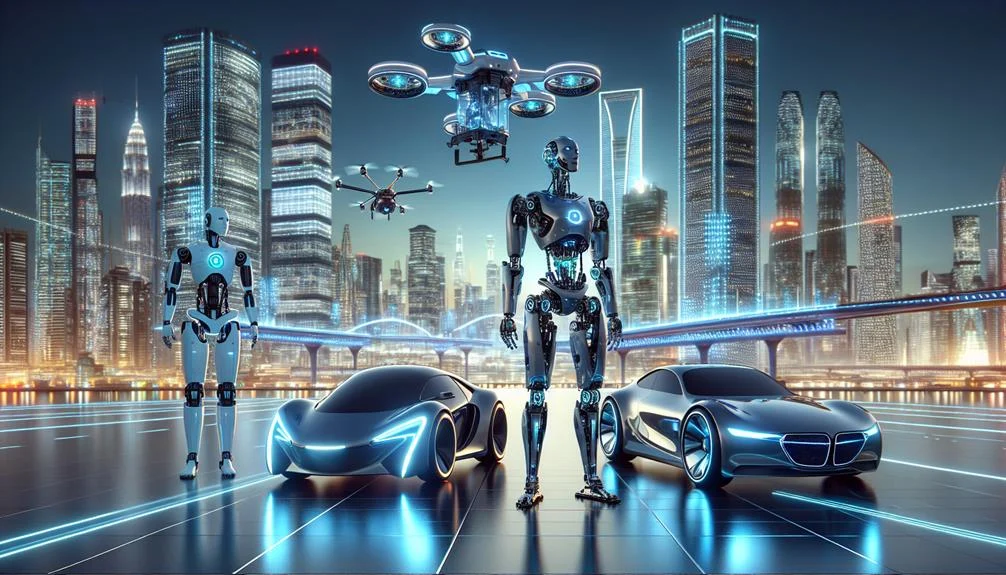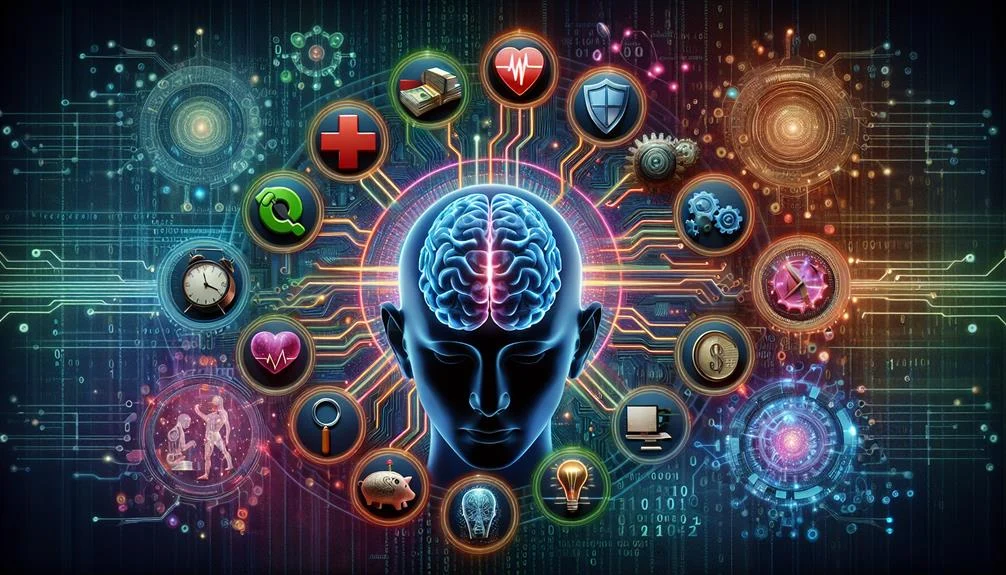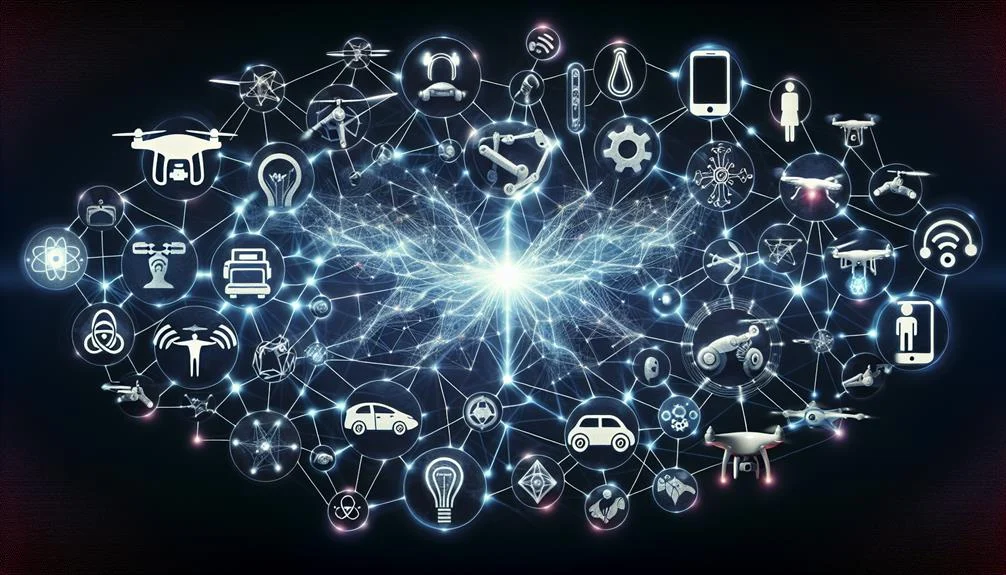Artificial Intelligence refers to a branch of computer science that involves developing systems capable of tasks that usually require human Intelligence, such as decision-making, visual perception, and language translation. It includes machine learning, natural language processing, and computer vision. AI has varying degrees of capability, from simple reactive machines to potentially self-aware systems. Despite its potential benefits in operational efficiency and consumer satisfaction, it raises concerns about job displacement, privacy, and ethical dilemmas. By exploring further, one can comprehend the transformative impact, real-world applications, and the importance of responsible development of AI.
Main Points
- Artificial Intelligence (AI) involves technologies like machine learning and natural language processing that enable machines to mimic human-like Intelligence.
- There are different types of AI, ranging from reactive machines to self-aware AI, each with varying capabilities and complexities.
- AI applications are widespread, revolutionizing sectors from healthcare and finance to e-commerce and cybersecurity.
- Despite its benefits, AI presents potential risks such as job displacement, privacy concerns, ethical dilemmas, and security vulnerabilities.
- Responsible development, ethical use, and regulation of AI technologies are crucial to balance its transformative impact and mitigate potential risks.
Understanding Artificial Intelligence
In today’s technological advancements, grasping Artificial Intelligence (AI) entails a comprehensive exploration of its diverse capabilities, involving technologies such as machine learning, natural language processing, and a variety of abilities that include reasoning, decision-making, and problem-solving. These AI capabilities enable machines to perform tasks that mimic human-like Intelligence, revolutionising various sectors.
Machine learning, a subset of Artificial Intelligence (AI), uses algorithms to parse data, learn from it, and make informed decisions or predictions. Employing profound learning models enables the computer to learn from the processed data and enhance its performance over time, akin to human learning from experience. Computer vision, a form of AI, is another potent tool that allows machines to interpret and understand the visual world.
AI’s application ranges from customer support services to autonomous driving systems, transforming how businesses operate and services are delivered. However, despite these advancements, debates persist about whether these AI technologies exhibit characteristics of artificial general Intelligence (AGI), implying the computer’s ability to understand, learn, and apply knowledge across various tasks, mirroring human cognitive skills.
Types of Artificial Intelligence (AI)

Different types of (AI)
- Narrow AI: This type of AI operates under a limited context and is a simulation of human intelligence. It can only perform a narrow task (like facial recognition or only internet searches) but it can’t perform beyond its limits.
- General AI: This type of AI can understand, learn, and apply its intelligence to any intellectual task that a human being can. It can perform any task that a human intellect can do.
- Superintelligent AI: This type of AI surpasses human intelligence, and capability. It’s hypothetical and not yet fully understood or known how it would affect humanity.
- Reactive Machines AI: These are basic types of AI systems that only react to current scenarios and can’t form experiences from the past.
- Limited Memory AI: This type of AI can learn from historical data and make decisions based on it.
- Theory of Mind AI: This type of AI could potentially understand human emotions, beliefs, and interactions, but it’s still not fully developed and remains largely theoretical.
- Self-aware AI: This is a future concept of AI where it has its own consciousness or is self-aware. This type of AI is not yet present and is considered a speculative concept.
Artificial Intelligence, are classify it into distinct types: Weak AI, Strong AI, Theoretical AI, and varying levels of intelligence ranging from reactive machines to self-aware AI, each with unique capabilities and limitations.
Weak AI involves machine learning and natural language processing to perform specific tasks such as speech recognition or image classification. It utilises deep learning techniques and computer vision, manifesting in systems like Siri or Alexa. This AI type is limited by its predefined neural network architecture and cannot exceed its programmed capabilities.
Strong AI, on the other hand, aims to develop Artificial General Intelligence (AGI), which can comprehend, learn, adapt, and implement knowledge across various domains, similar to human intelligence. This includes deep neural networks that are capable of independent reasoning and problem-solving.
Theoretical AI refers to hypothetical AI types, such as HAL from 2001: A Space Odyssey, demonstrating capabilities beyond our current technological reach.
The spectrum of AI types extends from reactive machines, which perform basic operations, to self-aware AI, which, although purely speculative now, could exhibit consciousness and self-awareness. Understanding these AI types is essential for appreciating the potential and constraints of artificial intelligence.
Importance and Benefits of Artificial Intelligence (AI)

The transformative nature of Artificial Intelligence becomes evident when examining its benefits and importance across a range of sectors, which encompass business operations, customer service, healthcare, finance, and more.
Artificial Intelligence, through machine learning algorithms, enhances operational efficiency by automating mundane tasks, thereby reducing human errors and saving valuable time. This augmentation of productivity is a substantial benefit that companies across the globe are capitalising on.
AI empowers businesses to provide personalised customer experiences. By analysing patterns in consumer behavior, AI can generate tailored recommendations and services that not only increase customer satisfaction but also boost business growth.
In healthcare, AI’s capabilities extend to assisting complex surgeries, particularly those around delicate organs, with the assistance of robotics. This revolutionary application showcases the potential of AI to transform medical practice.
In the finance sector, AI’s importance lies in its ability to detect fraud through advanced data analysis techniques. This capability greatly enhances the sector’s security and reliability.
Potential Risks of Artificial Intelligence (AI)

While the benefits of Artificial Intelligence (AI) are substantial and transformative, it is important to also consider the potential risks. Job displacement due to automation, privacy concerns linked to data collection and analysis, ethical dilemmas stemming from opaque decision-making processes, algorithmic biases that can perpetuate discrimination, and security vulnerabilities that could compromise data integrity and privacy are among the significant risks posed by AI.
To better comprehend the complexity and magnitude of these risks, consider the following table:
| Risk | Description | Mitigation Strategies |
|---|---|---|
| Job Displacement | Automation may lead to unemployment as AI replaces human roles. | Reskilling, Job creation |
| Privacy Concerns | AI’s data collection and analysis can infringe on individual privacy. | Data protection laws, Anonymisation |
| Ethical Dilemmas | AI decision-making may lack transparency and accountability, causing ethical issues. | Ethics guidelines, Transparency |
| Bias in Algorithms | AI algorithms can perpetuate discrimination against certain groups. | Bias audits, Diverse training data |
| Security Vulnerabilities | AI systems can be manipulated or hacked, threatening data integrity and privacy. | Robust security measures |
These present a call to action for technologists, policymakers and society to work together to mitigate these risks and ensure AI’s development is guided by principles of transparency, accountability and fairness.
Real-World Artificial Intelligence (AI) Applications

Moving from potential risks, it is equally significant to examine the breadth of real-world applications where artificial intelligence has proven to be transformative. In healthcare, machine learning algorithms are employed for medical imaging analysis, enhancing the precision of diagnoses and enabling personalised treatment recommendations. This is revolutionising patient care and advancing the practice of precision medicine.
In the finance sector, Artificial Intelligence (AI) technologies underpin fraud detection systems, enhancing their accuracy and speed. They also power algorithmic trading, a method that uses complex AI systems to make extremely fast trading decisions, optimising financial operations.
The rise of autonomous vehicles demonstrates AI’s transformative potential in transportation. AI systems enable navigation, obstacle detection, and on-road decision-making, leading to safer, more reliable, and efficient transportation systems.
AI-driven recommendation systems are ubiquitous in e-commerce and streaming services, improving user experience by tailoring content to individual preferences. In cybersecurity, AI is integral in detecting anomalies, predicting threats, and responding to cyberattacks in real-time. This ensures robust security measures that can adapt to evolving threat landscapes.
Future Perspectives on Artificial Intelligence

As we look ahead, the potential impact of Artificial Intelligence on future job markets, autonomous systems, healthcare, and ethical considerations emerges as a focal point of discussion, promising unprecedented transformations yet posing critical challenges. Advanced AI technologies could spur job creation, but they also risk job displacement, necessitating responsive governance frameworks to guarantee a balanced shift.
In the domain of autonomous systems and robotics, AI promises to drive significant advancements, optimising efficiency and precision. However, these developments raise privacy concerns and ethical considerations, requiring responsible development and deployment of AI technologies.
Healthcare applications of Artificial Intelligence could revolutionise diagnosis, treatment, and patient care, but these advances must be tempered with caution, respecting patients’ privacy rights and ensuring equitable access. The ethical use of AI in healthcare thus becomes paramount.
To address these challenges, AI regulation is being established globally. These governance frameworks aim to mitigate bias, preserve safety, and safeguard privacy, in an effort to manage the transformative impact of AI. This necessitates collaborations between governments, tech companies, and researchers, to strike a balance between innovation and ethical considerations.
Conclusion
In summary, while Artificial Intelligence (AI) undeniably presents a myriad of benefits, including efficiency and error reduction, it also poses potential risks, such as job displacement and privacy violations.
However, the real-world applications and future perspectives of AI indicate its inevitability and potential for growth.
It is essential to understand, regulate, and adapt to this revolutionary technology to harness its full potential while mitigating its associated risks.





